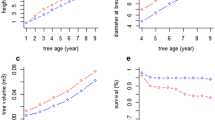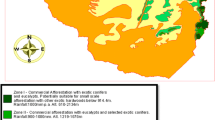Abstract
One approach to gain an insight into the genetics of tree architecture is to make use of morphologically divergent parents and study their segregating progeny in the F2 and backcross (B1) generations. This approach was chosen in the present study in which material of a three-generation pedigree growing side by side in a replicated plantation, was analyzed. The pedigree included Populus trichocarpa (T) and P. deltoides (D) parents, their F1 and F2 hybrids and their B1 hybrids to the D parent. The trees were grown in the environment of the T parent and measured for the first 2 years of growth. Nine quantitative traits were studied at the stem, branch and leaf levels of tree architecture, in which the original parents differed. Strong F1 hybrid vigor relative to the better parent (T) was expressed in growth and its components. Most quantitative traits in the F2 and B1 hybrids were intermediate between the T and D parents but displayed a wide range of variation due to segregation. The results from the analysis of variance indicated that all morphometric traits were significantly different among F2 and B1 clones, but the B1 hybrids were more sensitive to replicates than the F2. Broad-sense heritabilities (H 2) based on clonal means ranged from moderately high to high (0.50–0.90) for the traits studied, with H 2 values varying over age. The H 2 estimates reflected greater environmental “noise” in the B1 than in the F2, presumably due to the greater proportion of maladaptive D alleles in those hybrids. In both families, sylleptic branch number and length, and leaf size on the terminal, showed strong genetic correlations with stem growth. The large divergence between the two original parents in the traits studied, combined with the high chromosome number in Populus (2n=38), makes this pedigree well suited for the estimation of the number of quantitative trait loci (QTLs) underlying quantitative variation by Wright's biometric method (1968). Variation in several traits was found to be under the control of surprisingly few major QTLs: 3–4 in 2nd-year height and diameter growth, a single QTL in stem diameter/height ratio.
Similar content being viewed by others
References
Anderson JA, Sorrells ME, Tanksley SD (1993) RFLP analysis of genomic regions associated with resistance to preharvest sprouting in wheat. Crop Sci 33:453–459
Balocchi CE, Bridgwater FE, Zobel BJ, Jahromi S (1993) Age trends in genetic parameters for tree height in a nonselected population of loblolly pine. For Sci 39:231–251
Bradshaw HD, Stettler RF (1993) Molecular genetics of growth and development in Populus. I. Triploidy in hybrid poplars. Theor Appl Genet 86:301–307
Bradshaw HD, Stettler RF (1994 a) Molecular genetics of growth and development in Populus. II. Segregation distortion due to genetic load. Theor Appl Genet (in press)
Bradshaw HD, Stettler RF (1994 b) Molecular genetics of growth and development in Populus. IV. Mapping QTLs with large effects on growth, form, and phenology traits in a forest tree. Genetics (in press)
Bradshaw HD, Villar M, Watson BD, Otto KG, Stewart S, Stettler RF (1994) Molecular genetics of growth and development in PopUlus. III. A genetic linkage map of a hybrid poplar composed of RFLP, STS, and RAPD markers. Theor Appl Genet (in press)
Carson HL, Lande R (1984) Inheritance of a secondary sexual character in Drosophila silvestris. Proc Natl Acad Sci USA 81:6904–6907
Ceulemans RJ, Scarascia-Mugnozza G, Wiard BM, Braatne JH, Hinckley TM, Stettler RF, Isebrands G, Heilman PE (1992) Production physiology and morphology of Populus species and their hybrids grown under short rotation. I. Clonal comparisons of four-year growth and phenology. Can J For Res 22:1937–1948
Cockerham CC (1986) Modification in estimating the number of genes for a quantitative character. Genetics 114:659–664
Coyne JA, Lande R (1985) The genetic basis of species differences in plants. Am Nat 126:141–145
de Vicente MC, Tanksley SD (1993) QTL analysis of transgressive segregation in an interspecific tomato cross. Genetics 134:585–596
Dickmann DI (1985) The ideotype concept as applied to forest trees. In: Cannell MGR, Jackson JE (eds) Attributes of trees as crop plants. Titus Wilson and Son Ltd, Kendal, Cumbria, UK, pp 89–101
Doebley J, Stec A (1991) Genetic analysis of the morphological differences between maize and teosinte. Genetics 129:285–295
Doebley J, Stec A (1993) Inheritance of the morphological differences between maize and teosinte: comparison of results for two F2 populations. Genetics 134:559–570
Doebley J, Stec A, Wendel J, Edwards M (1990) Genetic and morphological analysis of a maize-teosinte F2 population: implication for the origin of maize. Proc Natl Acad Sci USA 87:9888–9892
Eckenwalder JE (1977) Systematics of Populus L. (Salicaceae) in southwestern North America, with special reference to Section Aigeiros Duby. PhD dissertation, University of California, Berkeley, California
Falconer DS (1989) Introduction to quantitative genetics, 4th edn. Longman Scientific and Technical, London
Hallé F, Oldeman AA, Tomlinson PB (1978) Tropical trees and forests: an architectural analysis. Springer-Verlag, Berlin New York
Hinckley, TM, Ceulemans R, Dunlap JM, Figliola A, Heilman PE, Isebrands JG, Scarascia-Mugnozza, Schulte PJ, Smit B, Stettler RF, van Volkenburgh E, Wiard BM (1989) Physiological, morphological and anatomical components of hybrid vigor in Populus. In: Kreeb KH, Richter H, Hinckley TM (eds) Structural and functional responses to environmental stresses. SPB Academic Publishing, The Hague, pp 199–217
Hinckley TM, Braatne J, Ceulemans R, Clum P, Dunlap J, Neuman D, Smit B, Scarascia-Mugnozza, van Volkenburgh E (1992) Growth dynamics and canopy structure. In: Mitchell CP, FordRobertson JB, Hinckley T, Sennerby-Forsse L (eds) Ecophysiology of short rotation crops. Elsevier Applied Science, London, pp 1–34
Honda H (1971) Description of the form of trees by the parameters of the tree-like body: effects of the branching angle and the branch length in the shape of the tree-like body. J Theor Biol 31:331–338
Lande R (1981) The minimum number of genes contributing to quantitative variation between and within populations. Genetics 99:541–553
Larson PR, Isebrands JG (1971) The plastochron index as applied to developmental studies of cottonwood. Can J For Res 1:1–11
Mitchell-Olds T (1986). Quantitative genetics of survival and growth in Impatients capensis. Evolution 40:107–116
Ollivier L, Janss LL (1993) A note on the estimation of the effective numbers of additive and dominant loci contributing to quantitative variation. Genetics 135:907–909
Paterson AH, Damon S, Hewitt JD, Zamir D, Rabinowitch HD, Lincoln SE, Lander ES, Tanksley SD (1991) Mendelian factors underlying quantitative traits in tomato: comparison across species, generations, and environments. Genetics 127:181–197
Ranney JW, Wright LL, Layton PA (1987) Hardwood energy crops: the technology of intensive culture. J For 85:17–28
Scarascia-Mugnozza G (1991) Physiological and morphological determinants of yield in intensively cultured poplars (Populus spp.). PhD dissertation University of Washington, Seattle, Washington
Singh M, Ceccarelli S, Hamblin J (1993) Estimation of heritability from varietal trial data. Theor Appl Genet 86:437–441
Stettler RF, Fenn RC, Heilman PE, Stanton BJ (1988) Populus trichocarpa x Populus deltoides hybrids for short rotation culture: variation patterns and four-year field performance. Can J For Res 18:745–753
Stettler RF, Bradshaw HD, Jr, Zsuffa L (1992) The role of genetic improvement in short rotation forestry. In: Mitchell CP, FordRobertson JB, Sennerby-Forsse L (eds) Ecophysiology of short rotation forest crops. Elsevier Applied Science, London, pp 284–308
Stuber CW, Lincoln SE, Wolff DW, Helentjaris T, Lander ES (1992) Identification of genetic factors contributing to heterosis in a hybrid from two elite maize inbred lines using molecular markers. Genetics 132:823–839
Thompson JN, Jr (1975) Quantitative variation and gene number. Nature 258:665–668
Tomlinson PB (1983) Tree architecture. Am Sci 71:141–149
Vega U, Frey KJ (1980) Transgressive segregation in inter- and intra-specific crosses of barley. Euphytica 29:585–594
Weber JC, Stettler RF, Heilman PE (1985) Genetic variation and productivity of Populus trichocarpa (T.&G.) and its hybrids. I. Morphology and phenology of fifty native clones. Can J For Res 15:384–388
Wright, S (1968) Evolution and the genetics of populations, Vol 1. Genetics and biometrical foundations. University of Chicago Press, Chicago
Zeng Z-B (1992) Correcting the bias of Wright's estimates of the number of genes affecting a quantitative character: a further improved method. Genetics 131:987–1001
Zeng Z-B, Houle D, Cockerham CC (1990) How informative is Wright's estimator of the number of genes affecting a quantitative, character? Genetics 126:235–247
Zsuffa L (1975) A summary review of interspecific breeding in the genus Populus. In: Proc 14th Meeting Canadian Tree Improvement Assoc, Part 2. Canadian Forest Service, Ottawa, pp 107–123
Zsuffa L, Sennerby-Forsse L, Weisgerber H, Hall RB (1993) Strategies for clonal forestry with poplars, aspens, and willows. In: Ahuja MR, Libby WJ (eds) Clonal forestry. II. Conservation and application. Springer-Verlag, Berlin Heidelberg, pp 91–119
Author information
Authors and Affiliations
Additional information
Communicated by P. M. A. Tigerstedt
Rights and permissions
About this article
Cite this article
Wu, R., Stettler, R.F. Quantitative genetics of growth and development in Populus. I. A three-generation comparison of tree architecture during the first 2 years of growth. Theoret. Appl. Genetics 89, 1046–1054 (1994). https://doi.org/10.1007/BF00224537
Received:
Accepted:
Issue Date:
DOI: https://doi.org/10.1007/BF00224537




